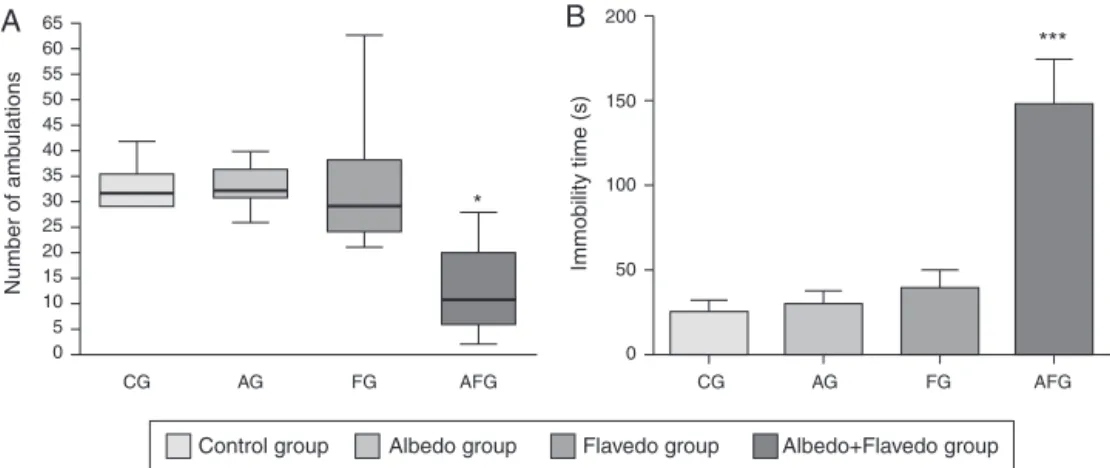w ww . e l s e v i e r . c o m / l o c a t e / b j p
Original
article
Effects
of
bark
flour
of
Passiflora
edulis
on
food
intake,
body
weight
and
behavioral
response
of
rats
Dandara
A.F.
Figueiredo
a,∗,
Liana
C.M.
Pordeus
a,
Luciano
L.
Paulo
b,
Renan
M.
Braga
b,
Diogo
V.
Fonsêca
b,
Bruno
S.
Sousa
a,
Maria
J.C.
Costa
a,
Maria
C.R.
Gonc¸
alves
a,
Klébya
H.D.
Oliveira
aaProgramadePós-graduac¸ãoemCiênciasdaNutric¸ão,CentrodeCiênciasdaSaúde,UniversidadeFederaldaParaíba,JoãoPessoa,PB,Brazil
bProgramadePós-graduac¸ãoemProdutosNaturaiseSintéticosBioativos,CentrodeCiênciasExatasdaNatureza,UniversidadeFederaldaParaíba,JoãoPessoa,PB,Brazil
a
r
t
i
c
l
e
i
n
f
o
Articlehistory:
Received30September2015 Accepted11February2016 Availableonline20June2016
Keywords: Behavioral
Passifloraedulis
Sedative Openfield
a
b
s
t
r
a
c
t
EffectsoftreatmentwiththebarkflourofPassifloraedulisSims,Passifloraceae,wereevaluated.Adultmale
Wistarratsweretreatedfor30days(130mg/kg,p.o.)withthealbedoflour,flavedoandfullbarkofP.edulis, correspondingtoalbedoassociatedwithflavedo.Behavioralresponseobservedaftertreatmentwithbark flourP.edulisshowedsedativeeffectsbythereductionofexploratoryactivityandincreaseddurationof immobilityintheopenfieldtestforthegroupofanimalsthatreceivedthealbedoflourassociatedwith theflavedo.Sedativeeffectswereobservedintheabsenceofmotorincoordinationormusclerelaxation. Foodintakeofexperimentalanimalswasnotchanged,buttheweightgainwasdecreasedbothinanimals thatreceivedonlyalbedoflour,andinthosewhoreceivedthefullbarkflour.Thefullbarkflourof
Passiflorashowedsedativeeffects,withoutanxiolyticeffectdetectableandmusclerelaxationormotor incoordination,andreducesbodyweightgain.
©2016SociedadeBrasileiradeFarmacognosia.PublishedbyElsevierEditoraLtda.Thisisanopen accessarticleundertheCCBY-NC-NDlicense(http://creativecommons.org/licenses/by-nc-nd/4.0/).
Introduction
Species ofPassiflora genus arepopularly indicated for treat-mentandpreventionofcentralnervoussystemdisorderssuchas depression,insomniaandanxiety.Thus,severalstudieshavebeen conductedto evaluatethesetherapeutic actions.The anxiolytic activityofPassifloraedulisSims,Passifloraceae,leafextract(Petry etal.,2001)aswellasthesedativepropertiesoftheaerialparts andthepericarpextracts(Senaetal.,2009;Dengetal.,2010;Klein etal.,2014),andantidepressanteffectofleavesandstemsethanolic extracthavebeenreported(Wangetal.,2013).
Besides, the evaluation of anti-inflammatory activity of the leaves extract and isolated chemical components of P. edulis (Montanher etal.,2007;Zucolottoetal.,2009)andantioxidant action of P.edulis fruit have alsobeen described (Zeraiket al., 2011;Martínezetal.,2012).Activephytochemicalcompoundswith antioxidantpropertiescaninhibitoxidativedamageandprevent theemergenceofinflammatorydiseasesanddisorders,including, theneurodegenerativeones(Praticò,2010;DelRioetal.,2013).
TheP.edulisfruitsarewidelyusedbythefoodindustry,andthe barkisconsideredabyproductoftheindustrialprocess(Ishimoto
∗ Correspondingauthor.
E-mail:liana@ccs.ufpb.br(D.A.Figueiredo).
etal.,2007;Gomesetal.,2010).Thisconsistsoftheexocarpor flavedo,partwithcolor,andmesocarporalbedo,middlewhitepart (Canterietal.,2010).
The bark of passion fruit (P. edulis) is traditionally used as a functional food due to its high concentration of soluble and insoluble fiber.The useof mesocarpof passion fruit is an importantdietarysupplementforthetreatmentofDiabetes mel-litus due toitspotential hypoglycemiceffect,and its ability to reducetriacylglyceridesandcholesterollevels(Corrêaetal.,2014; Grosseli et al., 2014). The investigation of biological activities is critical to recovery and valorization of byproduct that may induce considerable environmental, economic and therapeutic impacts.
Althoughtherehasbeendescribed theactivityofP.edulisas ananxiolyticorsedativeagent,moststudieshaveinvestigatedthe potentialofitsaerialpartandthebiologicalactivityofdifferentfruit parts,suchaspeels,seedsandpulp,itsnutritionalandtherapeutic aspectshavebeenlittleexplored(Gosmannetal.,2011).
Thisstudyinvestigatedthecentraleffects fromalbedoflour, flavedoandfullbarkofpassionfruit(P.edulis)usingbehavioral modelinrat(plusmaze)andotherstestsevaluatedadverseeffects (open field and rota rod), as locomotor and exploratory activ-ity. Physiological effects were also evaluated, food intake and body weight,thereby investigating theirpotentialnutraceutical properties.
http://dx.doi.org/10.1016/j.bjp.2016.02.010
Materialsandmethods
Animals
FortymalealbinoWistar(Rattusnorvegicus)rats,withthesame meanweight(200g),60daysold,wereusedinthestudy.Divided into fourgroups (n=10): control: CG, albedo: AG, flavedo: FG, Albedo+Flavedo:AFG,housedinboxes(n=5perbox)ofthesame treatmentgrouporcontrol.Allanimalswereprovidedfromthe vivariumProf.Dr.ThomasGeorgefromtheUniversidadeFederal daParaíbaandkeptthroughouttheexperimentsinwithwaterand standardfoodadlibitumunderilluminationstandards(light/dark cycle,12/12h),inatemperaturerangeof23±2◦C,andhumidity
(55±10%).EveryexperimentwasapprovedbytheEthics
Commit-teeonAnimalUse(CEUA)ofUFPBwithcertificateNo.1405/12.All animalswereundercareaccordingtotheethicalprinciplesofthe NationalCouncilControlofAnimalExperimentation–CONCEA/ 2013.
Flourpreparation
ThefruitsofPassifloraedulisSims,Passifloraceae,werecollected andidentifiedbytheStateCompanyofAgriculturalResearchof ParaíbaS.A.,Brazil–EMEPA.ThebarkflourofP.eduliswas devel-opedintheLaboratoryofFoodMicrobiologyandBiochemistryof UFPB,followingprotocoloftherespectivelaboratoryandIshimoto etal.(2007).Thepassionfruitswerewashedinrunningwater,the mesocarporalbedoandtheexocarporflavedoweremanually sep-arated.Thebarkswereimmersedinwaterandthen70%alcohol, bothdipsfor12h.Shortlyafter,thebarksweretakenintoa dry-ingovenwithaircirculationat64◦Cfor24h.Oncedry,thesewere
groundinanindustrialblenderandthensievedintoafine-mesh sievetoobtainthinnerflour.Beingthuspreparedthealbedoflour, flavedoflourandfullbarkflour,AlbedoassociatedtoFlavedo.
Treatment
The animals received 130mg/kg of flour, safe amount for animals without toxicity problem (Medeiros et al., 2009), cor-respondingtotheexperimentalgrouptowhich theybelonged. Controlgroup,Albedogroup,Flavedogroup,andAlbedo+Flavedo Group.Theflourwasdilutedwithfilteredwateraccordingtothe animalweightandadministeredbygavagetechnique,daily,always atthesametimes(7–9a.m.),for30days.TheCGreceivedonly filteredwater.
Behavioralteststoinvestigatethecentralaction
Openfieldtest
Onthefirstdayaftertheendoftreatment,from10to12a.m.,the animalsweresubjectedtotheOpenFieldapparatus.Theopenfield apparatusconsistinaboxdividedbyquadrantsdrawnatthe bot-tom,protectedbyanacryliccylinder,wheretheycanmovefreely duringthetesttime.Thelocomotorandexploratoryactivity (ambu-lation)wereevaluatedbythenumberofquadrantstraversed,and thebehavioralparametersofGrooming,Rearingandimmobility timewereanalyzedandregisteredina5minperiodofobservation foreachanimal(Baileyetal.,2008).
Motorcoordination
The effect on motor coordination was evaluated using the Rota Rod apparatus. The Rota Rod Test measures the muscle relaxation effect or motor incoordination produced, for exam-ple,byanxiolyticsand/orsedatives(TorresandEscarabajal,2002; Martínez-Vázquezetal.,2012).Thistestwasconductedthrough twosessions(habituationinapparatusandtest).Thefirstsession
(habituationinapparatus)wasperformedbeforethestartofthe 30daysoftreatment.Theanimalswereplacedinthedevicefora totaltimeof3min,includingfallsandrepositioning,for habitua-tiontotheapparatus(speed=6rpm).Thesecondsession(test)was conductedonthefirstdayaftertheendoftreatment,from2to4 p.m.,andthetimethattheanimalremainedontherotatingrod wasrecordedforperiodtill3min.
Elevatedplusmazetest
Themethodologyoftheelevatedplusmaze(EPM)testwas cre-atedbyListerin 1987beinga validatedmethodtoexplorethe neurobiologicalbasisofanxiety(TorresandEscarabajal,2002).The parametersevaluatedinthistestwere:numberofentriesintothe openandclosedarmsandtimespentintheopenandclosedarms. Eachanimalwasindividuallysubjectedtotheapparatusoncefor 5min,onthelastdayoftreatmentfrom10to12a.m.
Foodintakeandbodyweight
Thebodyweightoftheanimalswasmeasuredoncea week, alwaysatthesametime,from7to9a.m.,usingthedigitalelectronic scale(Bioprecisa,BS3000Amodel),3kgcapacityandsensitivityof 0.1g,duringthe30daysoftreatmentoftheanimals.Foodintake controllingwasperformedbyweighinguptheleftoverfoodand subtractingtheamountthatwasstipulatedandplacedasstandard. Threetimesaweekwereoffered500goffeedforbox,from7to 9a.m.However,everydayatthesametime itwascheckedthe amountof feedperbox and addedmore, ifnecessary,because thepurposeoftheexperimentwasnotcontrolconsumption,but onlyquantifyit.Theleftoverswerequantified,cleanreject(CR) anddirtyreject(DR),between7and9a.m.,threetimesaweek, throughoutthetreatmentperiod.Itwasobtainedthetotal con-sumptionpercage,andaveragedtheconsumptionperanimal.The feedconsumption(FC)wasdeterminedbythefollowingequation:
FC∗= ((1500+additional)−(CR+DR))/5∗∗
7
where*g/day/animal,and**numberofanimalsperbox.
Statisticalanalysis
ResultswerestatisticallyevaluatedusingGraphPadPrism4.00 (GraphPadSoftware, SanDiego, CA,USA).Data were expressed as mean±standard errorof the mean for parametric data and
median(percentile 25–75)for thenon-parametricresults. Vari-ableswereexaminedusingvarianceanalysis(OnewayANOVA), followedbyTukey’sPostHocorKruskal–Wallistestfollowedby Dunn’sPostHoc.OpenFieldtestandEPMvariableswere exam-inedusingKruskal–WallistestfollowedbyDunn’sposthocand/or ANOVAfollowedbyTukey’sPostHoc.RotaRodtest,foodintake andbodyweightthedifferenceswereanalyzedbyANOVAfollowed byTukey’sPostHoc.Differenceswereconsideredsignificantwhen p<0.05.
Results
Behavioralteststoinvestigatethecentralaction
Openfieldtest
65
A
B
200150
100
Immobility time (s)
Number of amb
ulations
50
0 60
55 50 45 40 35 30 25 20 15 10 5 0
CG AG FG AFG
*
CG
Control group Albedo group Flavedo group Albedo+Flavedo group
AG FG AFG
***
Fig.1.EffectofbarkflourofPassifloraedulisintheopenfieldtest.Theanimalsweretreatedfor30days(p.o.).Eachbarrepresentsthemean±S.E.M.orMedian(interquartile range)(n=10).*p<0.05;***p<0.001whencomparedwiththecontrolgroup.(A)Kruskal–WallistestfollowedbyDunn’sposthocand(B)ANOVAfollowedbyTukey’sPost Hoc.
theimmobilitytimeofthetestedanimalsusingtheopenfield appa-ratus(Fig.1B).StatisticalanalysisconfirmedthatAFG(148.1±26.0)
showedhigherimmobilitytimecomparedtobothCG(24.0±7.0;
p<0.001)andtheexperimentalgroupstreatedwithalbedoflour only(29.3±7.6;p<0.001)andflavedoflour(39.0±10.4;p<0.001). Inrelationtootherbehavioralparameterssettingsevaluatedon theOpenFieldapparatus(GroomingandRearing)nosignificant differencewasfound.
Motorcoordination
Thetreatmentwiththepassionfruitbarkdidnotchangethe animals performance on the Rota Rod apparatus in the three-minuteperiodofobservation,CG(148.6±12.7),AG(136.5±15.5),
FG(166.4±3.0),AFG(125.1±14.7),indicatingthatthebarkflour
ofP.edulisdoesnotcausemusclerelaxationinanimals(Fig.2).
Elevatedplusmazetest
Theentriesnumberofanimalsinopenandclosedarmsandthe timespentinclosedarmsshowednostatisticaldifferencebetween groups.However,animalstreatedwithalbedoflourassociatedto flavedo(62.89±22.06)had a highertime (s)spentin theopen
armsoftheapparatuscomparedtoCG(12.67±5.09;p<0.05).Fig.3
showsthedataobtainedintheEPM.
Foodintakeandbodyweightcontrol
Weightgain(g)ofanimalstreatedwithalbedoflourassociated toflavedo(79.6±5.60)andwiththealbedoflour(86.3±3.22)were
200
150
100
Time (s)
50
0
CG AG FG AFG
Fig.2.EffectofPassifloraedulisbarkflourintheRotaRodtest.Theanimalswere treatedfor30dayswiththealbedoflour,flavedoandfullbarkofP.edulis(130mg/kg, p.o.)orcontrol.Eachbarrepresentsthemean±S.E.M.(n=10).ANOVAfollowedby Tukey’sPostHoc.
lowerwhencomparedtoCG(102.8±1.52).However,therewas
nosignificantvariationbetweentheaveragefoodintake(Table1). Fig.4showsthebodyweight(g)ofAFGanimals(292.3±7.72)at
theendoftheexperiment,itwassignificantlylowerthantheCG (319.0±4.76;p<0.05)andtheFG(321.9±5.29;p<0.01).In the thirdweekofexperimenttheAFG(265.1±8.91)alreadyshowed
reductioninbodyweightcomparedtoCG(289.7±3.39;p<0.05) andFG(300.3±4.30;p<0.01).
Discussion
SpeciesofPassifloraarepopularlyusedandevaluatedin exper-imentalstudiesasagents anxiolytic, sedativesandtranquilizers (Dhawanetal.,2004;Gosmannetal.,2011;Sampathetal.,2011). Unlikestudiesdescribedintheliterature,usedonlyextractofplant, inthisstudywasevaluatedtheactivityofbarkofpassionfruiton theCNSoveramonth,andinnatura.
Regardinganxiolyticandsedativepropertiesofthegenus Passi-florathetreatmentwithalbedoflourassociatedtoflavedocaused adecreaseinambulationofanimalsintheopenfielddeviceandan increaseinimmobilitytime,whencomparedtoCG,demonstrating thesedativepropertyofthespecies.
Ourdataareinlinewithpreviousstudiesinwhichthe admin-istrationofextractsmadefromthepericarpofP.edulispresented sedativeeffectintheinducedsleepethylethertest(Senaetal., 2009),andinthetelemetrytestbythereductionofexploratory activity(Kleinetal.,2014).
Theelevatedplusmazetestisapreclinicaltestcommonlyused toinvestigatenewanxiolyticagents.Nutraceuticalswithanxiolytic properties reducetheanimal’snatural aversiontopromote the explorationof theenvironment intheopenarmofthe appara-tus.Studieswithnutraceuticalsorplantextractswithanxiolytic propertiesprove thatthetime spentintheopenarmsand the numberoftheseentriesisincreasedcomparedwithcontrolgroup
Table1
Meanvaluesoffoodintakeandweightgainoftheanimalsattheendof30daysof administrationofflourfromthebarkofPassifloraedulis.
Groups Feedconsumption(g/day/animal) Weightgain(g)
CG 26.82±2.05 102.8±1.52
AG 26.15±2.15 86.3±3.22a
FG 27.26±2.37 102.2±2.55
AFG 26.48±2.46 79.6±5.60a
CG,controlgroup;AG,albedogroup;FG,flavedogroup;AFG,albedo+flavedogroup. Dataareexpressedasmean±standarderror(n=10/group).
10
6 8
4
Number of entr
ies
2
0
CG AG
Entry in the open arms B Entry in the closed arms
A
C Time spent in the open arms D Time spent in the closed arms
FG AFG
100
60 80
40
Time (s)
20
0
CG AG FG AFG
*
300
150 200 250
100
Time (s)
50
0
CG AG FG AFG 10
6 8
4
Number of entr
ies
2
0
CG AG FG AFG
Fig.3.EffectofPassifloraedulisintheelevatedplusmazetest.Theanimalsweretreatedfor30dayswiththealbedoflour,flavedoandfullbarkofP.edulis(130mg/kg,p.o.) orcontrol.Eachbarrepresentsthemean±S.E.M.orMedian(interquartilerange)(n=10).*p<0.05whencomparedwiththecontrolgroup.ANOVAfollowedbyTukey’sPost HocorKruskal–WallistestfollowedbyDunn’sposthoc.
animals(Kuribaraetal.,2001;Carvalho-FreitasandCosta,2002; Landaverdeetal.,2009).
AFGshowedagreatertimespentintheopenarmswhen com-paredtoothergroups,however,thenumberofentriesintotheopen armswasnotsignificantcomparedwithcontrolgroup.A locomo-tionreductionispredictiveofapronouncedsedativeeffect,then, inordertoprovethattheanimalsspentmoretimeimmobileinthe openarmswasduetoitslowermotoractivityobservedintheopen field,suggestingthatthealbedoflourassociatedwithflavedoofP. edulispresentspossiblesedativeactivity.
Accordingtopreviousstudies,thesedativeeffectoftenappears atdoseshigherthanthedosethatpresentstheanxiolyticeffect (Dengetal.,2010;Lietal.,2011),whichmayexplainthefailureto detectapossibleanxiolyticeffectfromthebarkflourofP.edulis, sincethiswasadministeredforonemonthandnotinasingledose andwetestedonlyonedoseforeachgroup.
Using extracts fromthe aerial parts of P. edulis f. flavicarpa Dengetal.(2010)demonstratedanxiolyticeffectsatlowdosesand
400
300
200
100
0
0 1 2
Weeks
W
eight (g)
3
* **
* **
4
Control group Albedo group Flavedo group Albedo+Flavedo group
Fig.4.Evolutionofbodyweightoftheanimalsduringtheadministrationofbark flourfromPassifloraedulis.Eachbarrepresentsthemean±S.E.M.(n=10).*p<0.05 comparedCG;**p<0.01comparedtoFG.ANOVAfollowedbyTukey’sPostHoc.
sedationathigherdosesofextracts.TheaqueousextractofP.alata andP.edulisleavesshowedanxiolyticeffectsinelevatedplusmaze test,withoutthememoryprocesswaschanged.Andbothspecies showednochangeinspontaneouslocomotoractivityintheopen fieldtest(Barbosaetal.,2008).Whilenoanxiolyticeffectwasseen fortheleafextractofP.edulisbyLietal.(2011),andsedative activ-itysuggested.Differentfromourdata,administrationofaqueous extractoftheP.edulispericarpinducedanxiolyticbehaviorinmice inthelight/darkboxtest.
Thedifferencesobservedinthevariousstudieshowmuch anx-iolyticandsedativepropertiesofextractsfromPassifloramaybe attributedtodifferencesinexperimentalprocedures,preparation ofextracts,doses,regimensandusedadministrationways,and dif-ferentpartsoftheusedplants(Petryetal.,2001;De-Parisetal., 2002;Reginattoetal.,2006;Dengetal.,2010;Lietal.,2011).
Studiessuggestthattheflavonoidspresentinpassionfruitmay bepartlyresponsiblefortheanxiolyticand/orsedativeactivityof themanyPassifloragenusspecies,buttherearefewdataonaction mechanismsofplantcomponentsandtheiractivity(Coletaetal., 2006;Senaetal.,2009;Zucolottoetal.,2012).Flavonoidsmost frequentlycitesforspeciesofPassifloraareglycosylated(Zucolotto etal.,2009;Zhouetal.,2009).
highintakeoffiberhasbeenassociatedwithweightlossorless weightgain(Koh-Banerjeeetal.,2003;Bes-Rastrolloetal.,2006; Liuetal.,2003;Schroder,2010).Thereforeourfindingsare sup-ported by theliterature, since the increasedintake of fibers is accompaniedbyalossweightinAFG.
Several mechanisms have been suggested to explain how dietaryfiberhelps weightcontrolling (Slavin, 2005).The fibers decreasegastricemptying,absorptionofnutrientsandalterthe secretionofguthormones,inadditiontoinfluencingtheoxidation andstorageoffat(PereiraandLudwig,2001).AccordingtoSchroder (2010)fiberintakeisinverselyassociatedwithweightandbodyfat loss.
Conclusion
Itwasfoundthatfullbarkflour–albedoassociatedwithflavedo –fromP.eduliswhenadministeredforonemonthpromote seda-tiveeffectwithoutmusclerelaxanteffects.Additionally,itassists inreducingbodyweightgainwithoutcausingchangeinfood con-sumption.Thus,beforetheirbeneficialhealtheffects,itisimportant tonotethatthealbedoflourassociatedwithflavedomaybe inter-estingfortheproductionofnutraceuticals,sinceitshowedboth pharmacological,likesedativedrugs,andnutritionalproperties.
Authors’contribution
DAFF,LCMP,MJCCandMCRGareresponsibleforthe concep-tionanddesignofthestudy,analysisandinterpretationofdata, andpreparationofarticle.LLP,RMB,DVFandBSSparticipatedin thebehavioraltestsand providedsupportduringtheexecution ofwork.KHDO performedcriticalrevisionofthearticle.Allthe authorshavereadthefinalmanuscriptandapprovedthe submis-sion.
Conflictsofinterest
Theauthorsdeclarenoconflictsofinterest.
Acknowledgements
TheUniversidadeFederaldaParaíba,Brazil,forallowingusto conductthisresearchandEMEPAbythefruitsofPassifloraedulis provided.
References
Bailey,J.S.,Grabowski-Boase,L.,Steffy,B.M.,Wiltshire,T.,Churchill,G.A.,Tarantino, L.M.,2008.Identificationofquantitativetraitlociforlocomotoractivationand anxietyusingcloselyrelatedinbredstrains.GenesBrainBehav.7,761–769. Barbosa,P.R.,Valvassori,S.S.,Bordignon,C.L.,Kappel,V.D.,Martins,M.R.,Gavioli,
E.C.,Quevedo,J.,Reginatto,F.H.,2008.TheaqueousextractsofPassifloraalata andPassifloraedulisreduceanxiety-relatedbehaviorswithoutaffectingmemory processinrats.J.Med.Food11,282–288.
Bes-Rastrollo,M.,Martínez-González,M.A., Sánchez-Villegas,A.,Arrillaga,C.F., Martínez,J.A.,2006.Associationoffiberintakeandfruit/vegetableconsumption withweightgaininaMediterraneanpopulation.Nutrition22,504–511. Canteri,M.H.G.,Scheer,A.P.,Ginies,C.,Marie-Genevieve,C.,ClaireRenard,C.,
Wosi-acki,G.,2010.Importânciadotratamentotérmiconacascademaracujápara extrac¸ãodepectina.RBTA4,109–121.
Carvalho-Freitas,M.I.R.,Costa,M.,2002.Anxiolyticandsedativeeffectsofextracts andessentialoilfromCitrusaurantiumL.Biol.Pharm.Bull.25,1629–1633. Coleta,M.,Batista,M.T.,Campos,M.G.,Carvalho,R.,Cotrim,M.D.,Lima,T.C.,Cunha,
A.P.,2006.Neuropharmacologicalevaluationoftheputativeanxiolyticeffects ofPassifloraedulisSims,itssub-fractionsandflavonoidconstituents.Phytother. Res.20,1067–1073.
Corrêa,E.M.,Medina,L.,Barros-Monteiro,J.,Valle,N.O.,Sales,R.,Magalães,A.,Souza, F.C.A.,Carvalho,T.B.,Lemos,J.R.,Lira,E.F.,Lima,E.S.,Galeno,D.M.L.,Morales,L., Ortiz,C.,Carvalho,R.P.,2014.Theintakeoffibermesocarppassionfruit(Passiflora edulis)lowerslevelsoftriglycerideandcholesteroldecreasingprincipallyinsulin andleptin.J.AgingRes.Clin.Pract.3,31–35.
DelRio,D.,Rodriguez-Mateos,A.,Spencer,J.P.,Tognolini,M.,Borges,G.,Crozier,A., 2013.Dietary(poly)phenolicsinhumanhealth:structures,bioavailability,and
evidenceofprotectiveeffectsagainstchronicdiseases.Antioxid.RedoxSignal. 18,1818–1892.
Deng,J.,Zhou,Y.,Bai,M.,Li,H.,Li,L.,2010.Anxiolyticandsedativeactivitiesof Passifloraedulisf.flavicarpa.J.Ethnopharmacol.128,148–153.
De-Paris,F.,Reginatto,F.H.,Gosmann,G.,Quevedo,J.,Salgueiro,J.B.,Kapczinski,F., Ortega,G.G.,Schenkel,E.P.,2002.Pharmacochemicalstudyofaqueousextracts ofPassifloraalataDryanderandPassifloraedulisSims. ActaFarm.Bon.21, 5–8.
Dhawan,K.,Kumar,S.,Sharma,A.,2004.Passiflora:areviewupdate.J. Ethnophar-macol.94,1–23.
Farkas,S.,Berzsenyl,P.,Kárpati,E.,Kocsis,P.,Tarnawa,I.,2005.Simple pharmaco-logicaltestbatterytoassessefficacyandsideeffectprofileofcentrallyacting musclerelaxantdrugs.J.Pharmacol.Toxicol.Methods52,264–273.
Gomes,F.O.,Sousa,M.M.,Sousa,L.M.C.,Cardoso,J.R.,Silva,R.A.,2010. Desenvolvi-mentodebarrasdecereaisàbasedefarinhadealbedodemaracujáamarelo (Passifloraedulis).ActaTecnol.5,115–125.
Gosmann,G.,Provensi,G.,Comunello,L.N.,Rates,S.M.K.,2011.Composic¸ãoquímica easpectosfarmacológicosdeespéciesdePassifloraL.(Passifloraceae).Rev.Bras. Biocienc.9,88–99.
Grosseli,M.,Moraes,M.B.,Damaceno,B.F.,Okawabata,F.S.,Tardivo,A.C.B.,Alves, M.J.Q.F.,2014.Usodapolpaedacascadomaracujá(Passifloraedulisf.flavicarpa) sobreocolesterolemcoelhoscomhipercolesterolemiaexperimental.Rev.Pesq. Inov.Farm.6,12–20.
Ishimoto,F.Y.,Harada,A.I.,Branco,I.G.,Conceic¸ão,W.A.S.,Coutinho,M.R.,2007. Aproveitamentoalternativodacascadomaracujá-amarelo(Passifloraedulisf. var.flavicarpaDeg.)paraproduc¸ãodebiscoitos.RECEN9,279–292.
Klein,N.,Gazola,A.C.,Lima,T.C.M.,Nieber,E.S.K.,Butterweck,V.,2014.Assessment ofsedativeeffectsofPassifloraedulisf.flavicarpaandPassifloraalataextractsin mice,measuredbytelemetry.Phytother.Res.28,706–713.
Koh-Banerjee, P., Chu, N.F., Spiegelman, D., Rosner, B., Colditz, G., Willett, W.C., Rimm, E.,2003. Prospective study of the associationof changesin dietaryintake,physicalactivity,alcoholconsumption,andsmokingwith 9-ygaininwaistcircumferenceamong16587USmen.Am.J.Clin.Nutr.78, 719–727.
Kulkarni,S.G.,Vijayanand,P.,2010.Effectofextractionconditionsonthequality characteristicsofpectinfrompassionfruitpeel(Passifloraedulisf.flavicarpaL.). LWT–FoodSci.Technol.42,1026–1031.
Kuribara,H.,Iwata,H.,Tomioka,H.,Takahashi,R.,Goto,K.,Murohashi,N.,Koya,S., 2001.Theanxiolyticeffectofsho-jusen,aJapaneseherbalmedicine,assessed byanelevatedplus-mazetestinmice.Phytother.Res.15,142–147.
Landaverde,N.A.,Juárez-Flores,B.I.,Jiménez-Capdeville,M.E.,Ortiz-Pérez,M.D., 2009.AnxiolyticandsedativeeffectsofessentialoilfromCasimiroapringleion Wistarrats.J.Med.PlantsRes.3,791–798.
Li,H.,Zhou,P.,Yanga,Q.,Shen,Y.,Deng,J.,Li,L.,Zhao,D.,2011.Comparativestudies onanxiolyticactivitiesandflavonoidcompositionsofPassifloraedulis‘edulis’ andPassifloraedulis‘flavicarpa’.J.Ethnopharmacol.133,1085–1090. Liu,S.,Willett,W.C.,Manson,J.E.,Hu,F.B.,Rosner,B.,Colditz,G.,2003.Relation
betweenchangesinintakesofdietaryfiberandgrainproductsandchangesin weightanddevelopmentofobesityamongmiddle-agedwomen.Am.J.Clin. Nutr.78,920–927.
Martínez,R.,Torres,P.,Meneses,M.A.,Figueroa,J.G.,Pérez-Álvarez,J.A., Viuda-Martos,M.,2012.Chemical,technologicalandinvitroantioxidantproperties ofmango,guava,pineappleandpassionfruitdietaryfibreconcentrate.Food Chem.135,1520–1526.
Martínez-Vázquez, M., Estrada-Reyes, R., Martínez-Laurrabaquio, A., López-Rubalcavac,C.,Heinze,G.,2012.NeuropharmacologicalstudyofDracocephalum moldavicaL.(Lamiaceae)inmice:sedativeeffectandchemicalanalysisofan aqueousextract.J.Ethnopharmacol.141,908–917.
Medeiros,J.S.,Diniz,M.F.F.M.,Srur,A.U.O.S.,Pessoa,M.B.,Cardoso,M.A.A.,Carvalho, D.F.,2009.Ensaiostoxicológicosclínicosdacascadomaracujá-amarelo (Passi-floraedulis,f.flavicarpa),comoalimentocompropriedadedesaúde.Rev.Bras. Farmacogn.19,394–399.
Montanher,A.B.,Zucolotto,S.M.,Schenkel, E.P.,Fröde, T.S.,2007. Evidenceof anti-inflammatoryeffects ofPassifloraedulisin aninflammation model. J. Ethnopharmacol.109,281–288.
Pereira,M.A.,Ludwig,D.S.,2001.Dietaryfiberandbody-weightregulation. Obser-vationsandmechanisms.Pediatr.Clin.N.Am.48,969–980.
Petry,R.D.,Reginatto,F.H.,De-Paris,F.,Gosmann,G.,Salgueiro,J.B.,Quevedo,J., Kapczinski,F.,Ostega,G.G.,Schenkel,E.P.,2001.Comparative pharmacologi-calstudyofhidroethanolextractsofPassifloraalataandPassifloraedulisleaves. Phytother.Res.15,162–164.
Praticò,D.,2010.TheneurobiologyofisoprostanesandAlzheimer’sdisease.Biochim. Biophys.Acta1801,930–933.
Reginatto,F.H.,De-Paris,F.,Petry,R.D.,Quevedo,J.,Ortega,G.G.,Gosmann,G., Schenkel,E.P.,2006.Evaluationofanxiolyticactivityofspraydriedpowders oftwoSouthBrazilianPassifloraspecies.Phytother.Res.2,348–351. Sampath,C.,Holbik,M.,Krenn,L.,Butterweck,V.,2011.Anxiolyticeffectsoffractions
obtainedfromPassifloraincarnataL.intheelevatedplusmazeinmice.Phytother. Res.25,789–795.
Schroder,K.E.E.,2010.Effectsoffruitconsumptiononbodymassindexandweight lossinasampleofoverweightandobesedietersenrolledinaweight-loss inter-ventiontrial.Nutrition26,727–734.
Slavin,J.L.,2005.Dietaryfiberandbodyweight.Nutrition21,411–418.
Torres,C.,Escarabajal,M.D.,2002.Validationofabehavioralrecordingautomated systemintheelevatedplus-mazetest.LifeSci.70,1751–1762.
Wang,C.,Xu,F.,Shang,J.,Xiao,H.,Fan,W.,Dong,F.,Hu,J.,Zhou,J.,2013. Cycloar-tanetriterpenoidsaponinsfromwatersolubleofPassifloraedulisSimsandtheir antidepressant-likeeffects.J.Ethnopharmacol.148,812–817.
Yapo,B.D.,Koffi,K.L.K.,2008.Dietaryfibercomponentsinyellowpassionfruitrind –apotentialfibersource.J.Agric.FoodChem.56,5880–5883.
Zeraik,M.L.,Serteyn,D.,Deby-Dupont,G.,Wauters,J.N.,Tits,M.,Yariwake,J.H., Angenot,L.,Franck,T.,2011.Evaluationoftheantioxidantactivityofpassion
fruit(PassifloraedulisandPassifloraalata)extractsonstimulatedneutrophils andmyeloperoxidaseactivityassays.FoodChem.128,259–265.
Zhou,Y.J.,Li,H.W.,Tan,F.,Deng,J.,2009.Studiesonthechemicalconstituentsof Passifloraedulisf.flavicarpa.J.Chin.Med.Mater.32,1686–1688.
Zucolotto,S.M.,Fagundes,C.,Reginatto,F.H.,Ramos,F.A.,Castellanos,L.,Duque, C.,Schenkel,E.P.,2012.AnalysisofC-glycosylflavonoidsfromSouthAmerican PassifloraspeciesbyHPLC-DADandHPLC-MS.Phytochem.Anal.23,232–239. Zucolotto,S.M.,Goulart,S.,Montanher,A.B.,Reginatto,F.H.,Schenkel,E.P.,Fröde,

